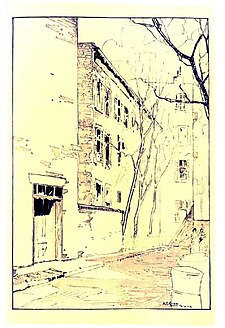Patchin Place
40°44′06″N 73°59′58″W / 40.73499°N 73.99931°W


Patchin Place is a gated
History
The property that became Patchin Place was once part of a farm belonging to

In the early 20th century, Patchin Place became popular with writers and artists, with its small residences, that were apart from but still accessible to the cafe life of the Village. Indoor plumbing, electricity, and steam heat were added in 1917.[8] In 1920, Grace I. Patchin Stuart, the last remaining member of the Patchin family, sold the property to the Land Map Realty Corporation, and the houses were converted into small apartments.[9] E. E. Cummings moved in three years later; he wrote that "the topfloorback room at 4 Patchin Place ... meant Safety & Peace & the truth of Dreaming & the bliss of Work".[10]
In 1929 the gate at the entrance was added and nearby Jefferson Market prison was torn down, as Patchin Place resident John Cowper Powys noted in a letter to his brother:[11]
They've gone and put up iron gates at the entrance to Patchin Place — in the middle of the entrance — leaving the little openings by the new brick posts free. And they've pulled down the Prison — but so far not the Clock tower. In the foundations of this fallen
Singer Towerfrom the entrance of Patchin Place....
The clock tower that Powys refers to is Jefferson Market Court, now a library branch. Berenice Abbott photographed the view of the tower above Patchin Place in 1937.[8]
The
Present day

Patchin Place remains physically almost unchanged. It even retains its 19th-century
In March 2022, investment firm Firebird Grove bought all 11 buildings in Patchin Place from Morgan Holding Capital for just over $32 million.[17]
Notable residents
|
|
References
Notes
- ^ a b c New York City Landmarks Preservation Commission. "NYCLPC Greenwich Village Historic District Designation Report, volume 1" Archived 2017-02-12 at the Wayback Machine, NYCLPC (1969)
- ^ ISBN 978-0-8129-3107-5., p. 131
- ^ a b c Koeppel, David (2003). "A Bastion of Literature Is a Bulwark for Therapy". The New York Times. Archived from the original on 2016-03-04. Retrieved 2007-06-24.
- ISBN 1-4000-4735-8.
- ^ Gray, Christopher (March 1, 1992). "Streetscapes: Readers' Questions; A J.P. Morgan Brownstone and a Hospital for Italians". The New York Times. Retrieved 2007-06-24.
- ^ ISBN 0-8021-4064-5.
- ^ Chapin, Anna Alice (2005). Greenwich Village. Project Gutenberg.
- ^ a b c "Berenice Abbott: Patchin Place". Museum of the City of New York. Archived from the original on 2007-07-10. Retrieved 2007-06-24.
- ^ "Modern Progress in Patchin Place: Quaint Plot in New Hands After Family Ownership of One Hundred Years". The New York Times. May 2, 1920. pp. RE1.
- ^ "Patchin Place, 1925". [home page of SPRING: The Journal of the E. E. Cummings Society]. Retrieved 2007-06-25.
- ^ Powys, John Cowper. Letters to His Brother Llewellyn. Quoted in "4 Patchin Place". [powys-lannion.net]. Retrieved 2007-06-24.
- ISBN 0-292-71546-3.
- ISBN 0-14-017842-2.
- ^ Field, 22, 236.
- ^ Levine, Nancy J. (1993). "Works in Progress: the Uncollected Poetry of Barnes's Patchin Place Period". The Review of Contemporary Fiction. 13 (3): 186–200.
- ^ "Alleys of Greenwich Village". Forgotten NY. Retrieved 2007-06-24.
- ^ "Greenwich Village Cul-De-Sac Sells for $32M". The Real Deal New York. 2022-03-16. Retrieved 2022-03-19.
- ^ a b "Old Patchin Place Loses Weidee, Its Guiding Hand". The New York Times. May 18, 1924. pp. X4.
- ISBN 0-670-88236-4.
- ^ ISBN 1-58322-554-4.
- ^ New York World-Telegram and The Sun, Jan. 4, 1962, p. 23. Patchin Pl.: Quiet Refuge for Writers
- ^ Hersey, Harold (1937). Pulpwood Editor. New York, NY: Frederick A. Stokes Company.
- ^ "NEW YORK BOOKSHELF/NONFICTION; How Chinese Were Depicted, How Cummings Took His Tea". The New York Times. September 22, 2002. pp. section 14, page 10. Retrieved 2007-06-24.
- ^ "4 Patchin Place". [powys-lannion.net]. Retrieved 2007-06-24.
- ^ Keith, W. J. (December 2005). "John Cowper Powys's Autobiography: A Reader's Companion". [Aids to the Reading of John Cowper Powys]. p. 84. Retrieved 2007-06-24.
- ISBN 0-06-114502-5.
External links
- New York Changing — photographs of Patchin Place in 1937 and 1997
- Forgotten New York — photographs and information
